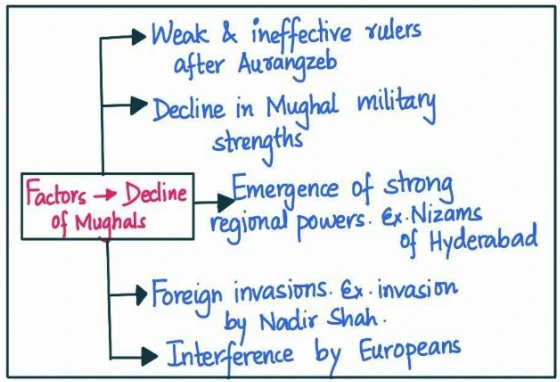Answer:
|
How to approach the question
- Introduction
- Write briefly about the decline of the Mughal Empire.
- Body
- Write about the factors that led to the decline of the Mughal Empire
- Write about the rise of regional powers in 18th-century India with the decline of the Mughal empire.
- Conclusion
- Give appropriate conclusion in this regard.
|
Introduction
The decline of the Mughal Empire was a complex process influenced by a combination of various factors marking a significant turning point in Indian history, leading to political fragmentation and the rise of regional powers.
Body
The decline of the Mughal Empire can be attributed to several factors:
- Economic Drain: Heavy taxation and excessive revenue demands from the Mughal court led to economic strain and reduced agricultural productivity.
- Decline in Military Strength: The decline in the Mughal military’s strength and effectiveness made it vulnerable to external threats and internal rebellions. External invasions, such as the invasion of Nadir Shah in 1739, resulted in the plunder of Delhi and the looting of the empire’s wealth.
- Weak Succession: The empire witnessed a series of weak and ineffective rulers who were unable to maintain the stability and unity of the empire after Aurangzeb. For example, the succession struggle between Aurangzeb’s sons, leading to the War of Succession, weakened the empire’s central authority.
 Religious Tensions: Aurangzeb, who enforced strict Islamic orthodoxy and suppressed other religions, led to religious tensions and alienated non-Muslim populations. The imposition of jizya and the destruction of Hindu temples further fueled social and religious divisions,
Religious Tensions: Aurangzeb, who enforced strict Islamic orthodoxy and suppressed other religions, led to religious tensions and alienated non-Muslim populations. The imposition of jizya and the destruction of Hindu temples further fueled social and religious divisions,- Advent of Europeans: Europeans had started to interfere in the native politics. The British East India Company gained significant influence through trade and wars eventually transformed it into political control over large parts of India. Example- Battle of Buxar and Plassey.
- Rise of regional aspirations: Regional governors and nobles began to assert greater autonomy and gradually established their own independent states. One significant example is the rise of the Maratha Empire in western India. Other examples are Jats, Sikhs etc.
- Shifting allegiance of zamindars and jagirdari crisis in Mughal empire
- Vast empire became difficult to be governed by centralised authority.
Rise of regional powers with the decline of the Mughal empire:
- Nizam of Hyderabad: Asaf Jah I, established the Asaf Jahi dynasty in the early 18th century.
- Bengal: The Nawab of Bengal, Murshid Quli Khan, declared Bengal as an independent state in 1717.
- Sikh Confederacy: The Sikh community, under the leadership of charismatic figures like
Maharaja Ranjit Singh, capitalised on the weakening Mughal rule.
- Maratha Empire: Under the leadership of Shivaji and later the Peshwas, they expanded their influence across western and central India, establishing a vast kingdom.
- Rajput States: The Rajput states, such as Jaipur, Jodhpur, and Udaipur, took advantage of the power vacuum to assert their autonomy and expanded their territories.
- Travancore: Ruling over the region of present-day Kerala, the rulers of Travancore expanded their territory and established a well-administered and prosperous kingdom.
- Mysore Kingdom: Rulers like Hyder Ali and his son Tipu Sultan expanded Mysore’s territories and challenged British dominance in southern India.
Conclusion
The decline of the Mughal Empire was a complex and multifaceted process that occurred over several decades. It led to a significant shift in the power dynamics of India, with the rise of regional powers shaping the political landscape of the 18th century.
To get PDF version, Please click on "Print PDF" button.
 Religious Tensions: Aurangzeb, who enforced strict Islamic orthodoxy and suppressed other religions, led to religious tensions and alienated non-Muslim populations. The imposition of jizya and the destruction of Hindu temples further fueled social and religious divisions,
Religious Tensions: Aurangzeb, who enforced strict Islamic orthodoxy and suppressed other religions, led to religious tensions and alienated non-Muslim populations. The imposition of jizya and the destruction of Hindu temples further fueled social and religious divisions,
Latest Comments